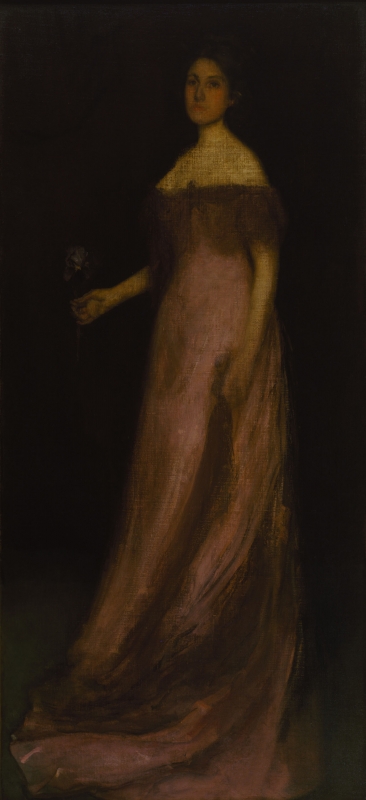Composition

H. Dixon & Son, Rose et vert: L'Iris – Portrait of Miss Kinsella, photograph, 1894/1904, GU Whistler PH4/57/2
An early photograph, possibly taken during Whistler's lifetime, shows greater distinction between the light floor and the dark background.
The Terra website comments:
'Emerging from a shadowy, dim background, the woman assumes a deliberately artificial pose, holding an iris in her right hand and gathering the folds of her long, low-cut dress in the left. The train of her diaphanous pink gown sweeps across the ground in front of her, as if she has just turned and paused in mid-stride, but her direct gaze evinces “the utmost calm and assurance,” according to the artist.' 1
Technique
It is painted on rather coarse canvas, which, as Dunstan pointed out, means that although it was repeatedly rubbed and scraped down it did not end up with a surface like linoleum. 2
Nevertheless there is an uncomfortable contrast between the head and the very thoroughly scraped down areas of her bare shoulders. Her right hand, holding the iris, is carefully but not very accurately drawn, and her other hand is a blur lost in the sweep of her dress.
The Pennells commented:
'We saw it in the Fitzroy Street studio when it was so perfect that one more day's work seemed to us a danger. But Whistler scraped it out and painted it over ruthlessly, never satisfied, always striving to improve, though nobody could help, at one moment, feeling that to change anything must be to the picture's disadvantage. In no other portrait did he ever paint flesh with such perfection. Face and neck had the rich golden quality of a Titian, with a subtlety of modelling beyond even the Venetian master. One day, when E. [Elizabeth R. Pennell] went to the studio, he had just scraped down neck and bust for no other reason she could discover than because he could not get the hand to come right with the rest of it. It was to be lovelier than ever, he said. It retains but a shadow of its old loveliness.' 3
The Terra website adds:
'Whistler had painted it in a series of thin glazes that he applied and then partly removed, painstakingly building up the layers to achieve an ethereal, luminous appearance. In 1897... Joseph Pennell … was afraid Whistler’s continued work would ruin it. Dissatisfied, Whistler then proceeded to scrape out and repaint various areas of the surface, in several places allowing the coarse texture of the canvas to interfere with the appearance of the pigment. As a result, the soft, limpid effect Whistler intended disappeared in the rather scrubbed surface of the painting.' 4
Conservation History
The Pennells say it was, at Whistler's death, 'a mere phantom of its former self, painted over and over, and yet left unfinished ... an impression of the first splendid beauty of the picture, and the charm of the colour scheme ... remains.' 5 It has been, over the years, both cleaned and restored, but is rather dark. Some areas, such as the face, look very thin and insubstantial. Because the images reproduced above were done by different processes or taken under varying light conditions, and because they are mostly undated, it is impossible to draw conclusions as to what exactly represents Whistler's work, and what, that of later conservators.
Frame
205.7 x 102.6 cm (81 x 40 3/8") .
Last updated: 25th November 2020 by Margaret








